Summary
Research Interests
Published June 2019
I work on the evolution of species diversity. Why does life evolve into the distinct species? What are mechanisms shape speciation and adaptive divergence? What are the adaptive causes and consequences of species diversity? The work combines theory with experimental, molecular, genomic and field approaches across a range of organisms.
More information at lab website here
- Theory of species origins and evolutionary dynamics
- Statistical methods for identifying units and mechanisms of diversification
- Evolution without sex: speciation, adaptation and evolutionary genomics of bdelloid rotifers
- Evolutionary dynamics of microbial communities
Selected Publications
Journal Articles
Barraclough TG, Nowell R, Wilson C, et al., 2018, Comparative genomics of bdelloid rotifers: insights from desiccating and nondesiccating species, PLOS Biology, Vol:16, ISSN:1544-9173
Barraclough TG, Fujisawa T, Aswad A, 2016, A rapid and scalable method for multilocus species delimitation using Bayesian model comparison and rooted triplets, Systematic Biology, Vol:65, ISSN:1076-836X, Pages:759-771
Eyres I, Boschetti C, Crisp A, et al., 2015, Horizontal gene transfer in bdelloid rotifers is ancient, ongoing and more frequent in species from desiccating habitats, BMC Biology, Vol:13, ISSN:1741-7007
Fiegna F, Moreno-Letelier A, Bell T, et al., 2015, Evolution of species interactions determines microbial community productivity in new environments, ISME Journal, Vol:9, ISSN:1751-7362, Pages:1235-1245
Barraclough TG, 2015, How Do Species Interactions Affect Evolutionary Dynamics Across Whole Communities?, Annual Review of Ecology Evolution and Systematics, Vol:46, ISSN:1543-592X, Pages:25-48
Humphreys AM, Barraclough TG, 2014, The evolutionary reality of higher taxa in mammals, Proceedings of the Royal Society B: Biological Sciences, Vol:281, ISSN:0962-8452
Frost GS, Walton GE, Swann JR, et al., 2014, Impacts of Plant-Based Foods in Ancestral Hominin Diets on the Metabolism and Function of Gut Microbiota In Vitro, Mbio, Vol:5, ISSN:2161-2129
Tang CQ, Leasi F, Obertegger U, et al., 2012, The widely used small subunit 18S rDNA molecule greatly underestimates true diversity in biodiversity surveys of the meiofauna, Proceedings of the National Academy of Sciences of the United States of America, Vol:109, ISSN:0027-8424, Pages:16208-16212
Perron GG, Lee AEG, Wang Y, et al., 2012, Bacterial recombination promotes the evolution of multi-drug-resistance in functionally diverse populations, Proceedings of the Royal Society B: Biological Sciences, Vol:279, ISSN:0962-8452, Pages:1477-1484
Lawrence D, Fiegna F, Behrends V, et al., 2012, Species interactions alter evolutionary responses to a novel environment., Plos Biol, Vol:10
Waterman RJ, Bidartondo MI, Stofberg J, et al., 2011, The effects of above- and belowground mutualisms on orchid speciation and coexistence, American Naturalist, Vol:177, Pages:E54-E68


